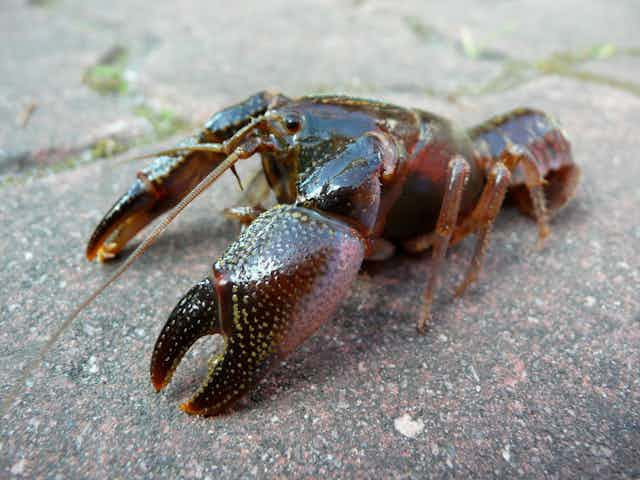The buttongrass plains, swamps and heathy slopes of western Tasmania support a suite of burrowing crayfish species in the endemic genera Ombrastacoides and Spinastacoides.
These nutrient-poor, acid peatlands are an unusual habitat for crayfish, and there are few other places in the world where peatlands are so extensively burrowed by them. In fact it is likely that they play a significant role as ecosystem engineers, aerating and draining the soils, improving conditions for the growth of plants and providing habitat for an assemblage of other species.
A recent review of these peatland crayfish revealed a number of new species, several of which have restricted ranges. Although the ranges of many of the Ombrastacoides species are protected within the Tasmanian Wilderness World Heritage Area, some are threatened.
Status
The Denison Rain Crayfish is only found in the upper reaches of the Little Denison River catchment and two small tributaries of the Weld River. Its range lies outside the World Heritage Area, in the contentious tall wet forest belt that lies adjacent to its eastern boundary. Its total range is well under 100 km2, and within that its actual area of occurrence is very much less. It requires access to the water table in its burrows for all but very short periods, so it is confined to swampy areas, seepages and roadside ditches. It is difficult to estimate the area of these habitats, but it is very unlikely to exceed 30% of the whole range.
The Short-tailed Rain Crayfish has a known range of less than 10 km2 to the south east of the West Coast Range, in the valley of the King River. Its area of occupancy is not known, but it is a burrower in peaty soils and suitable habitat is abundant (or was, before flooding, see below).
Threats
Much of the distribution of the Denison Rain Crayfish is in wet eucalypt forest of high commercial value and 10-15% of its range has either been cleared for agriculture or recently clear-felled and regenerated. However, forestry coupes are only likely to have less suitable habitat where they include drainage depressions or unrecognized Class 4 streams, or where roads have had an impact on watercourses.
Lake Burbury was created for hydro-electric power generation in the 1990s before the Short-tailed Rain Crayfish was discovered. The dam flooded most of the known localities for this species and no survey work has yet been done to establish how much of its population remains. It is very unlikely that the crayfish has persisted in the new lake. Soon after Lake Pedder was flooded crayfish were commonly found in the guts of trout caught in the new lake, but they are very rarely found now.
In general, burrowing crayfish are threatened by processes that affect water, soil structure and food. These include roads or clearing, burning or conversion to plantations. While natural fire has little effect on burrowing crayfish, too-frequent hazard reduction burning or repeated high intensity fires can permanently reduce vegetation cover, thus changing the microclimate and reducing the availability of food. In peatlands, intense fires can remove the soil itself.
Climate change overlies all of these factors and it is likely that species at the eastern edges of the range of the genus, such as the Denison Rain Crayfish, will have their ranges reduced by the drying climate in the near future.
Strategy
Burrowing crayfish present both unusual opportunities and unusual difficulties in establishing their geographical range and status. On the one hand, as effectively sedentary animals, their locations can be mapped with great accuracy and population size can easily be assessed by counting burrows.
On the other hand, discovering what species inhabits a burrow inevitably involves the burrow’s destruction. DNA-based methods may soon provide a non-destructive alternative.
The Denison Rain Crayfish has already been recognized as a Priority Species by the Forest Practices Authority, which approves logging plans in Tasmanian forests. This means that the needs of this species must be taken into account in the preparation of the mandatory Forest Practices Plans that are drawn up for any substantial forestry activity in Tasmania.
The priority for the conservation of the Short-Tailed Rain Crayfish is simply to find out how much (if any) of its population remains. When that has been established any on-going threats can be considered.
Conclusion
The peat burrowing crayfish of Tasmania appear to be more closely related to the crayfish of New Zealand and Madagascar than to the rest of the Australian crayfish fauna. This makes the conservation of the full diversity of this group globally important.
The Conversation is running a series on Australian endangered species. See it here

